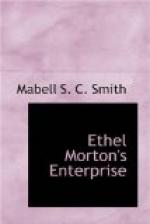“O, there was clattering
of steel and mustering in array,
And shouts and wild huzzas
of men, impatient of delay,
As came the scouts swift-footed
in—’They fly! the foe! they fly!
They’ve fired the powder
magazine and blown it to the sky.’
“All the English had to do was to walk in, put out the fire, repair the fort and re-name it.”
“What did they call it?”
“After the great statesman—Fort Pitt.”
“That’s where ‘Pittsburg’ got its name, then! I never thought about its being in honor of Pitt!” exclaimed Helen.
“It is ‘Pitt’s City,’” rejoined her grandfather. “And this street,” he added somewhat later when they were speeding in a motor bus to a hotel near the park, “this street is Forbes Street, named after the British general. Somewhere there is a Bouquet Street, to commemorate another hero of the war.”
“I saw ‘Duquesne Way’ marked on the map,” announced Ethel Blue.
On the following morning they awakened to find themselves opposite a large and beautiful park with a mass of handsome buildings rising impressively at the entrance.
“It is Schenley Park and the buildings house the Carnegie Institute. We’ll go over them by and bye.”
“It’s a library,” guessed Dicky, who was not too young to have the steelmaker’s name associated with libraries in his youthful mind.
“It is a library and a fine one. There’s also a Music Hall and an art museum and a natural history museum. You’ll see more fossil ferns there, and the skeleton of a diplodocus—”
“A dip-what?” demanded Roger.
“Diplodocus, with the accent on the plod; one of the hugest animals that ever walked the earth. They found the bones of this monster almost complete in Colorado and wired them together so you can get an idea of what really ‘big game’ was like in the early geological days.”
“How long is he?”
“If all the ten members of the U.S.C. were to take hold of hands and stretch along his length there would be space for four or five more to join the string.”
“Where’s my hat?” demanded Roger. “I want to go over and make that fellow’s acquaintance instanter.”
“When you go, notice the wall paintings,” said his mother. “They show the manufacture and uses of steel and they are considered among the finest things of their kind in America. Alexander, the artist, did them. You’ve seen some of his work at the Metropolitan Museum in New York.”
“Pittsburg has the good sense to have a city organist,” Mr. Emerson continued. “Every Sunday afternoon he plays on the great organ in the auditorium and the audience drifts in from the park and drifts out to walk farther, and in all several thousand people hear some good music in the course of the afternoon.”
“There seem to be some separate buildings behind the Institute.”
“The Technical Schools, and beyond them is the Margaret Morrison School where girls may learn crafts and domestic science and so on.”




